US holiday shopping 2022: ’Tis the season to be (cautiously) optimistic
October 25, 2022

Despite continued economic uncertainty, US shoppers are looking forward to spending for the holidays. Retailers that offer good value will come out on top.
As the weather cools and the air turns crisp, US retailers are once again facing challenges for the holiday-shopping season. The past couple of years saw severe, systemic supply chain disruptions and high case rates for COVID-19. However, the landscape is more nebulous this time. Consumer demand has softened, while inventory levels are higher than they’ve been in years, and company earnings continue to face scrutiny from Wall Street as some profits decline.
Meanwhile, US consumers continue to send mixed signals. Their sentiment about the economy remains historically low, and they still have concerns about inflation. They’re looking for savings by trading down and seeking value where they can find it. But many of them have cash to spend—and they say they’re not just willing but eager to spend and splurge. People in the United States are more excited for the holidays than they’ve been in years.
With this divergent dynamic in mind, many retailers have kicked off the holiday-shopping season earlier than ever. Some retailers are doubling down on membership benefits to drive loyalty and increase their share of wallet. Others are announcing price match guarantees and widening return windows during the holidays to reach more consumers. Retailers are also making adjustments that are less visible to consumers: by using data and investing in automation to predict shopping preferences and manage inventory, or by hiring fewer seasonal employees in anticipation of slower growth.
This article presents findings from our latest Consumer Pulse Survey; they show that there are good reasons for US retailers to be optimistic. The following are the key discoveries:
- The holidays are back. After nearly three years of suppressed behavior resulting from the COVID-19 pandemic, people are primed to go all out to celebrate for the holidays. In the survey, 55 percent of US respondents say they are excited about holiday shopping, and most people have the savings to spend.
- Holiday shopping has already begun. Concerns about ongoing inflation and product availability—along with retailers’ early planning this year—have encouraged US consumers to shop earlier than ever: 56 percent have already started shopping in October instead of waiting until later in the season.
- Consumers are looking for value. Given economic uncertainty, consumers are being more surgical about how they spend. Nearly half of US survey respondents say they would switch stores if they found a better price elsewhere.
This Consumer Pulse Survey was in the field from September 27 to September 29, 2022, and garnered responses from more than 1,000 consumers in the United States (sampled and weighted to match the general US population, ages 15 to 74). These insights build on the work we have undertaken since March 2020, when we began to regularly conduct consumer surveys and combine our research and analysis with third-party data on US spending to glean insights into how consumer sentiment has shifted since the beginning of the COVID-19 pandemic.
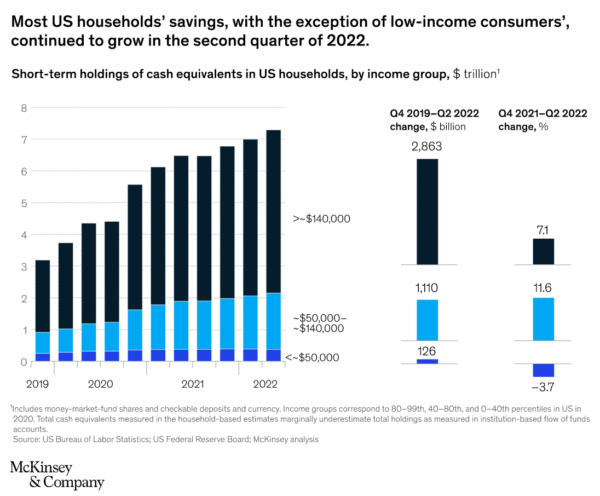
Most consumers continue to grow their nest eggs. As people pulled back on spending throughout the COVID-19 pandemic and received stimulus checks from the government, their savings went up. That trend continues. US families have added more than $4 trillion to their coffers since late 2019. While middle- and higher-income households’ savings continue to grow, lower-income households are beginning to draw down on their savings.
Even though many US consumers are in a better financial position than they were before the pandemic, inflation has remained above 8 percent since March 2022. The costs of day-to-day necessities, such as groceries and gas, have dramatically increased. In response to inflation concerns and skyrocketing expenses, 74 percent of US consumers across all ages and income groups say they are trading down—mostly by adjusting quantities for essential goods and delaying purchases for discretionary goods.
Most US households’ savings, with the exception of low-income consumers’, continued to grow in the second quarter of 2022.
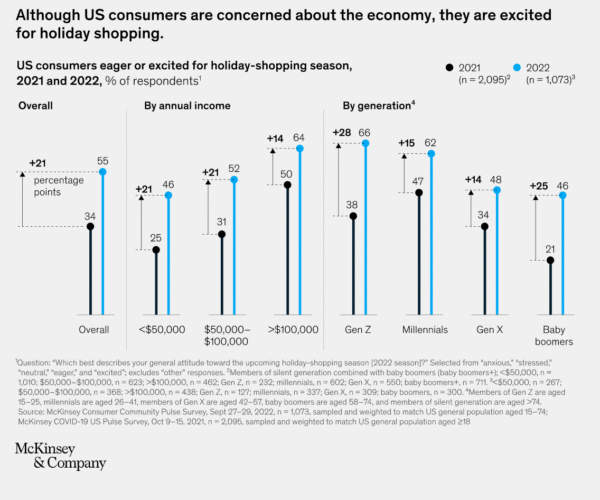
It’s the most wonderful time of the year. For the first holiday season since the pandemic started, US consumers are feeling bright and cheery. More than half of those surveyed say they are eager or excited for the shopping season, up from around one-third last year.
There’s a general uptick in holiday spirit across all US income and age groups. Low- and medium-income consumers each saw a 21-percentage-point increase in optimism. Baby boomers’ rate of optimism more than doubled since 2021, with nearly half feeling good about holiday shopping this year. Higher-income and younger consumers are especially excited, with around two-thirds eager or excited for the holidays.
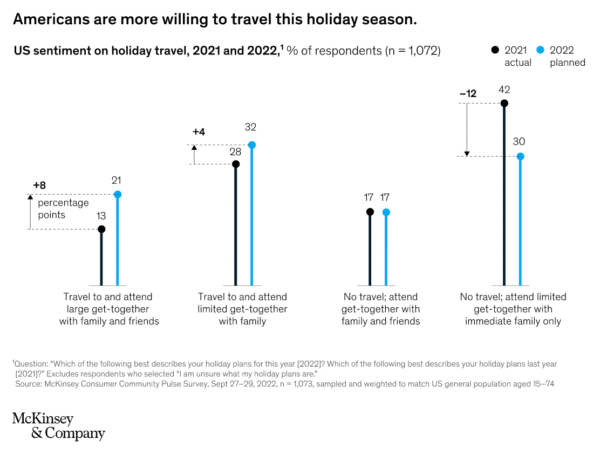
Hitting the holiday road. As pandemic fears and isolation have ebbed this year, some people are finally ready to get out of their homes and go see loved ones in person for the holidays. While 30 percent of US survey respondents say they will still limit in-person gatherings, compared with a year ago, there’s a 12-percentage-point increase in those who say they plan on traveling to see family or friends. The majority of that increase comes from people who say they are going to large gatherings.
The increased comfort with travel this year over last is especially noticeable among Gen Zers (16 percentage points higher), millennials (six percentage points higher), and those who have higher incomes (14 percentage points higher). This willingness to leave home may drive a resurgence in foot traffic to stores. Of US respondents, 42 percent say they intend to browse in stores, compared with 37 percent last year.
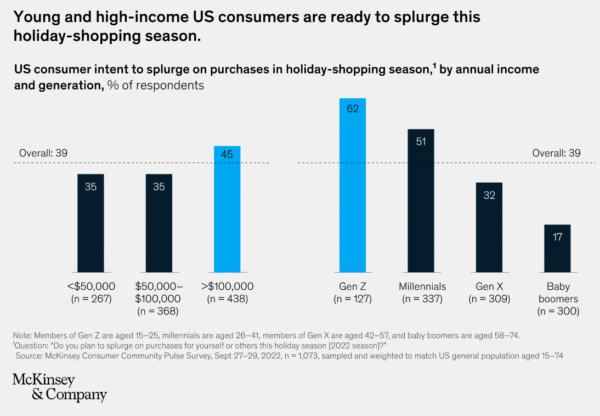
Ready to spend. Despite concerns about the economy, renewed holiday cheer coupled with growing savings means that US consumers want to spend. Nearly 40 percent of survey respondents say they intend to splurge for themselves or for others. This intention to spend extra on items is especially evident among Gen Zers and millennials.
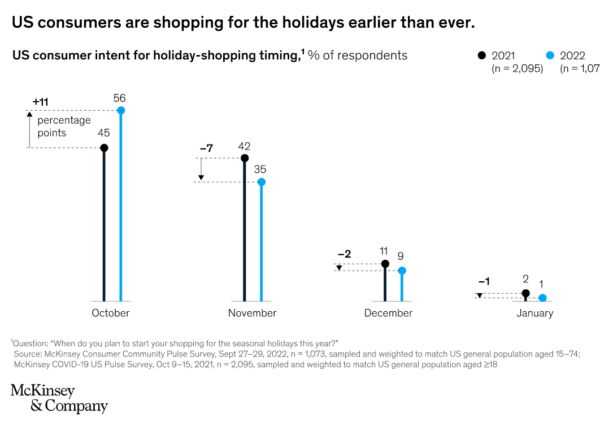
October is the new November. US consumers are already spotting jingle bells and tinsel in store aisles. Everything is happening earlier this year. Around one-third of US survey respondents say they plan to start shopping sooner compared with last year. Instead of waiting until the Black Friday sales of Thanksgiving weekend, 56 percent say they will have already started their holiday shopping before October is over.
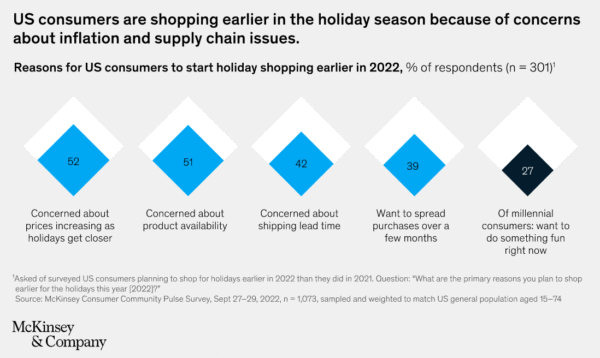
Consumers are shopping early to offset inflation and supply concerns. Some consumers still worry about holiday shipping delays (perhaps because of residual scars from last year’s supply chain woes). However, most—more than 50 percent—of respondents who are shopping earlier this year say they’re doing it because they have concerns about increasing prices or product availability as the holidays get nearer.
Several retailers have already moved their promotions to earlier in the year to match this intent to spend earlier. Amazon put on its earliest-ever holiday-shopping event, the Prime Early Access Sale, in mid-October. Both Target’s Deal Days and Walmart’s Deals for Days campaigns led up to and surrounded Amazon’s promotions.
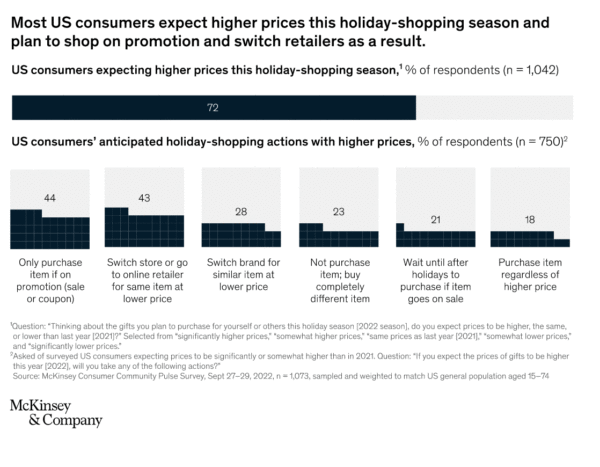
Consumers are shopping deliberately and looking for value. Given that the holiday-shopping season has started so early, US consumers have more time than usual to exercise discernment about what they buy. Perhaps unsurprisingly with the increase of in-person gatherings, 27 percent of consumers anticipate that they’ll spend more on essential goods, such as food, this year than they did last year. That group anticipates their share of wallet around accessories, cosmetics, and toys to get hit the hardest.
Given the current inflationary environment, 72 percent of US survey respondents expect to pay more for gifts this year, so they’re looking for bargains. Of those consumers, 44 percent say they’re seeking sales or coupons, and 43 percent say they will switch retailers if they find a lower price elsewhere.
US consumers are also much more likely than last year (by 31 percentage points) to use retailer websites. They are also more likely (by ten percentage points) to use promotional emails from relevant retailers to browse and compare prices before purchase. Additionally, they plan to go to big-box or discount retailers to save money.
Most US consumers expect higher prices this holiday-shopping season and plan to shop on promotion and switch retailers as a result.
Consumer-facing companies can capitalize on US consumers’ optimism and willingness to spend during the holiday season by focusing on providing value:
- Adapt to your consumer. Not all consumers are the same, and retailers can tailor their approaches to the people they want to reach. Higher-income consumers have more to spend and are more willing to splurge on discretionary items, whereas lower-income consumers are more likely to give holiday gifts that fill a need. Given people’s propensity to delay purchases, retailers should focus on inspiring consumers with the right items at the right price and at the right time.
Set earlier, wider-reaching promotions. If retailers haven’t already done so, they should kick off the holiday-shopping season now with distinctive value, differentiated promotions, and personalized offerings. US consumers are shopping already and looking for value, so building on their enthusiasm early could lead to momentum. Leveraging excess inventory to trigger the holiday spirit now can have the added benefit of clearing store space for new arrivals after Black Friday in late November. Providing unique in-store offerings and services could reach more consumers now that foot traffic is back up. - Allow for more purchasing flexibility. By offering convenience and accessibility to value, retailers can reach more consumers and garner more loyalty. That could include employing a price match guarantee or offering flexible fulfillment options, such as in-store pickup, expedited shipping toward the end of the holiday season, and temporarily widening the window for returns.
- Maintain a long-term pulse on trade-offs. Delivering value will help retailers win this holiday-shopping season. But for long-term health, companies should also constantly consider the trade-offs between the holiday frenzy and the longer-term potential impact of any changes on brand image and overall profitability. Understanding details on customer acquisition during the holidays and deploying customer-relationship-management tactics soon after the holidays can help retailers retain loyalty.
About the author(s)
Colleen Baum is a partner in McKinsey’s New York office; Joyce Chai is an associate partner in the Bay Area office, where Kelsey Robinson is a senior partner; Tamara Charm is a partner in the Boston office; and Tom Skiles is a capabilities and insights expert in the Chicago office.
The authors wish to thank Katie Boys, Sara Chamberlain, Andrea Leon, Jason Rico Saavedra, Daniela Sancho Mazzara, and Meera Singh for their contributions to this article.































